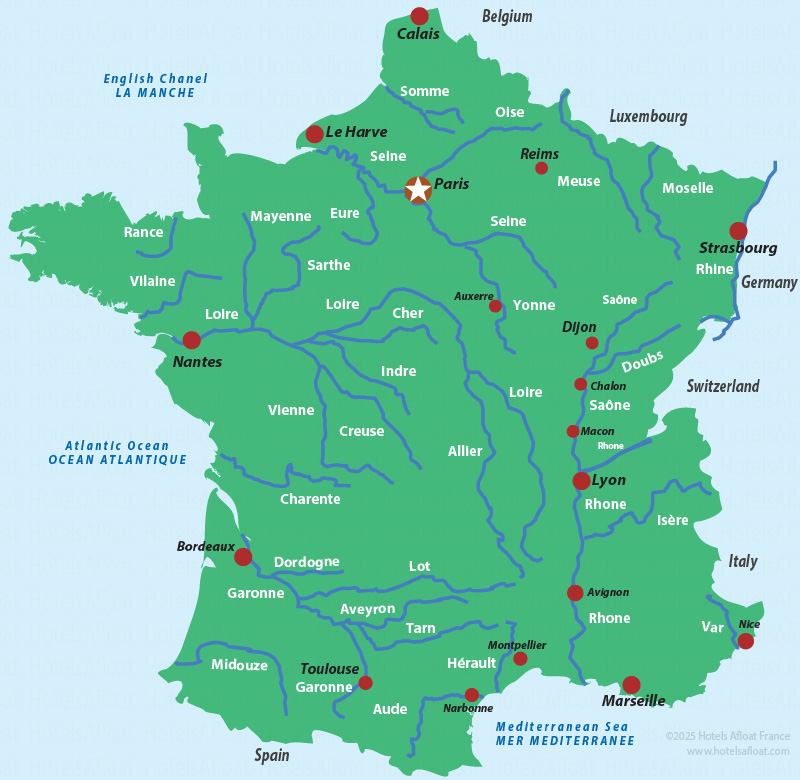Imagine, if you will, a river that’s not just a waterway, but a living, breathing testament to a long and complex relationship between two nations. A river that has witnessed wars and treaties, famine and prosperity, and has ultimately served as a bridge, connecting rather than dividing. This is the story of the Rhine, a river that for centuries has marked the border between France and Germany, playing a vital role in shaping their intertwined destinies.

Image: www.hotelsafloat.com
The Rhine, a mighty river that flows through the heart of Europe, has seen it all. From the Roman Empire to the Napoleonic Wars, from the Industrial Revolution to the modern era, this waterway has been an integral part of the story of both France and Germany. It has served as a source of life – providing water for irrigation, trade routes for commerce, and a source of energy for industries. The Rhine is more than just a river; it is a symbol of their shared history, their ongoing struggles, and their hope for a peaceful future.
A History Etched in Water: Tracing the Rhine’s Influence
The Rhine’s story begins with its very beginnings. It rises in the Swiss Alps, a majestic torrent fueled by melting glaciers, and flows for over 800 miles before finally reaching the North Sea. It has traversed through a landscape that is as varied as it is beautiful – from the snow-capped peaks of the Alps to the rolling hills of the German countryside to the fertile plains of the Netherlands.
For centuries, the Rhine has been a vital artery for trade and transportation. Roman galleys once sailed its waters, transporting goods and soldiers to distant lands. Medieval merchants used its banks as bustling marketplaces, trading spices, textiles, and other valuable commodities, shaping the economic landscape of Europe. The Rhine’s strategic location, forming a natural border between France and Germany, has instilled it with a unique historical significance. Over time, the river witnessed the rise and fall of empires, the ebb and flow of power, and the constant evolution of the Franco-German relationship.
A Lifeline of Unity: The Rhine as a Bridge Between Nations
The Rhine isn’t just a historical river; it’s a vital symbol of unity and cooperation. In the wake of the devastations of World War II, the French and Germans recognized the need for reconciliation. The river became a focal point of this healing process. In 1951, the French and German governments signed the Treaty of Paris, marking a new era of cooperation. The Rhine, once a divider, became a symbol of their commitment to a shared future.
Today, the Rhine is a thriving economic hub. Renowned industries like chemicals, pharmaceuticals, and automobiles have flourished along its banks, transforming the river into a symbol of economic prosperity. It also plays a critical role in regional tourism, with its picturesque villages, castles, and vineyards attracting millions of visitors every year.
A Future Full of Potential: Navigating the Challenges
However, the Rhine also faces challenges. Pollution from industrial activity, the threat of climate change, and the increasing demand for water resources all pose significant threats to this vital waterway. To secure the future of the Rhine, both France and Germany have prioritized environmental protection and sustainable development. Collaborative efforts involve reducing pollution, restoring ecosystem health, and promoting responsible water management practices.
The Rhine is a testament to the enduring power of nature and the enduring will of humans. It serves as a constant reminder of the need for cooperation and understanding. It reminds us that even in the face of conflict and division, there is always the possibility for reconciliation and growth.

Image: www.freepik.com
Expert Insights and Actionable Tips
Dr. Annelise Dubois, a renowned historian specializing in Franco-German relations, emphasizes that “The Rhine is a living history book, a tangible representation of the tumultuous relationship between France and Germany. By studying its evolution, we can gain valuable insights into the dynamics of their past and the challenges they face today.”
To embrace the spirit of the Rhine and contribute to its preservation, we can all do our part. Here are a few practical tips:
- Support sustainable tourism: Travel responsibly, choose eco-friendly accommodations, and minimize your environmental impact when exploring the Rhine region.
- Advocate for responsible water management practices: Support policies that prioritize clean water and responsible resource allocation.
- Embrace cultural exchange: Seek opportunities to learn about French and German cultures, celebrate their shared history, and promote understanding between these two nations.
French German River
The Rhine: A Legacy of Harmony
The Rhine is a river of beauty, history, and hope. It is a reminder that even the most complex relationships can evolve, overcome adversity, and find unity. By embracing its legacy of harmony, we can strive towards a future where cooperation and understanding prevail, ensuring a healthy and prosperous future for the Rhine and the nations it connects.






